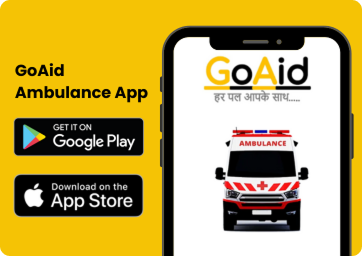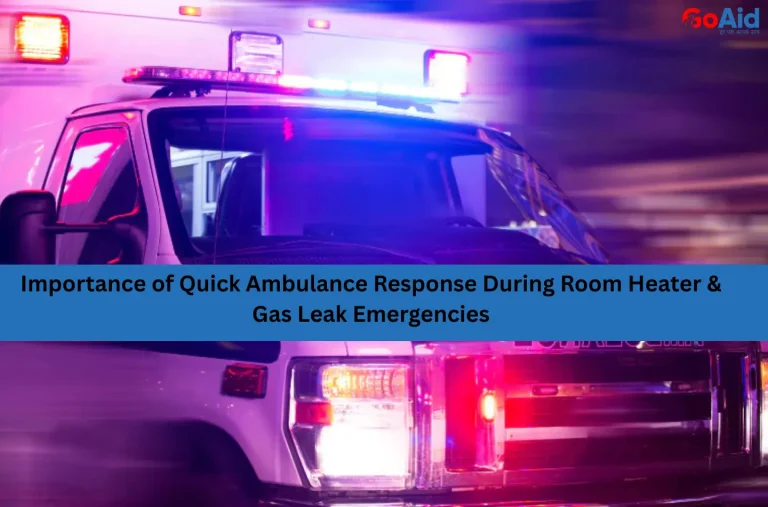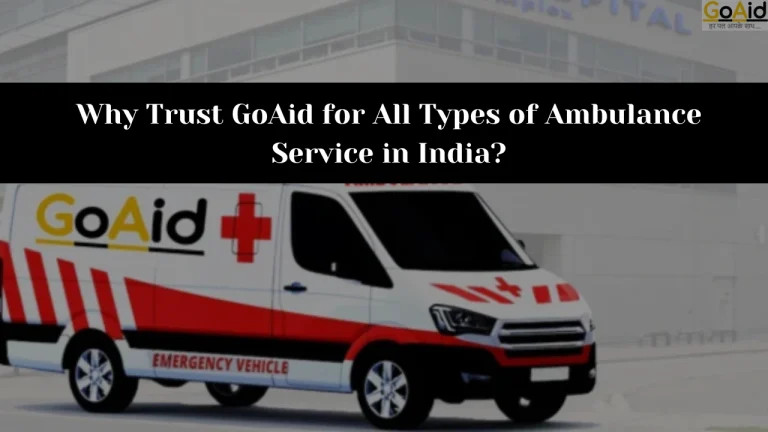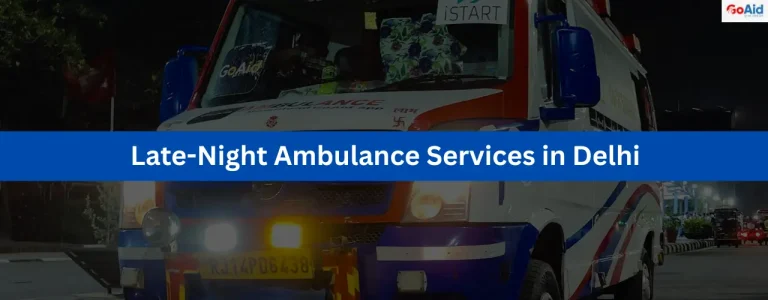In India, Airports & Railway Stations are some of the crucial transportation and traveling ways, through which IndiaŌĆÖs majority of population and businesses travel across the country. However, these locations always have a great need for on-site ambulances deployed all the time. Still, there are many locations in India where airport ambulances and ambulances near the railway stations are not easy to find.
This is why, in this blog, we have added all the details about the need for ambulance services in the Airports & Railway Stations. Are you also one of those who want to know all these details about the need for on-site ambulances near airports and railway stations? Then read this blog to the end.
So, letŌĆÖs start-
Overview of the Airports & Railway Stations in India
India hosts one of the largest transportation networks in the world, with over 150 functional airports and more than 7,000 railway stations spread across urban and rural zones. Every day, millions of passengers depend on these transit hubs for domestic and international travel. This makes them vital for connectivity and economic flow.
However, with such massive footfall, passenger safety medical services often fall short in these busy environments. Health risks due to congestion, extreme weather, fatigue, and underlying medical conditions make these spots highly sensitive to emergencies.┬Ā
Despite this, on-site ambulance services at transportation zones are still not consistently available across all airports and railway stations. The need for ambulance at airports and railway stations is more than just a safety measureŌĆöitŌĆÖs a necessity for handling medical emergencies at airports & railway stations and providing urgent care at transport hubs when every second matters.
Common Health & Safety Problems at Airports & Railway Stations
Despite being highly crowded and high-security zones, Airports and Railway Stations in India often lack rapid medical support, increasing the risk of unaddressed emergencies that demand on-site ambulance services at transportation zones.
1. Sudden Cardiac Arrest
A major health emergency seen at transit hubs is cardiac arrest, especially among older passengers. Medical emergency at airports & railway stations needs immediate support via ambulance for airports and railway stations to save lives.
2. Fainting and Dehydration
Travel stress and long queues cause passengers to faint or suffer from dehydration. Emergency ambulances at transit hubs can handle these issues quickly before conditions worsen, especially in IndiaŌĆÖs humid or extreme heat zones.
3. Accidental Falls
Slippery floors, escalator mishaps, or platform gaps often lead to injuries. Having an ambulance at the airport and railway premises ensures instant first aid and safe transfer to nearby hospitals in such incidents.
4. Chronic Illness Flare-Ups
Passengers with diabetes, asthma, or hypertension often experience health complications mid-travel. On-site ambulance service at transportation zones helps in providing urgent medication or paramedic attention during critical times.
5. Passenger Overcrowding Injuries
Festive seasons and peak travel hours lead to crowd surges and stampedes. For such health emergencies in public transport hubs, a quick ambulance in crowd management areas can prevent a small incident from turning tragic.
6. Accidents During Boarding or Deboarding
Slips, pushing, or misjudging moving steps during boarding/deboarding can cause fractures or head injuries. First aid at airports & stations, followed by an emergency ambulance, is crucial in these high-risk situations.
7. Stress and Panic Attacks
Travelers, especially those afraid of flying or confined spaces, often face anxiety or panic attacks. Having a transit zone emergency care setup, including an ambulance for the airports, ensures emotional and medical support when needed.
The Risky Nature of Airports & Railway Stations
Airports and Railway Stations in India are high-traffic, high-pressure environments where medical emergencies at airports & railway stations are increasingly common. With thousands of passengers moving through these hubs daily, the chance of health emergencies in public transport hubs is significant.┬Ā
Delays, long queues, stressful security checks, poor ventilation, and overcrowding contribute to incidents such as fainting, panic attacks, and cardiac arrests. These zones lack consistent on-site ambulance service at transportation zones. This makes emergency responses slow and often inadequate.┬Ā
Due to their vital role in the nationŌĆÖs travel ecosystem, both airports and railway stations must ensure passenger safety with medical services through reliable ambulances for airports & railways to prevent delays, medical complications, or even loss of life.
Current Problems Faced
Despite the obvious need, many Indian transit hubs are still unprepared for emergencies. Most railway station emergency response systems lack on-site medical personnel or quick access to ambulance for railway stations.
Similarly, several smaller airports operate without dedicated ambulance for airports, leaving passengers dependent on city services, which are delayed by traffic. First aid at airports & stations is minimal and often handled by untrained staff.┬Ā
There’s also poor coordination between station authorities and nearby hospitals, resulting in longer response times. Emergency ambulance at transit hubs is seen as optional rather than essential, and there is no standardized protocol across IndiaŌĆÖs transport sector to ensure availability of on-site ambulance service at transportation zones.
Why Ambulance Services Are Essential for the Airports & Railway Stations?
The presence of an on-site ambulance service at transportation zones ensures rapid medical help during critical moments. Here’s why ambulance for airports & railway stations is not just necessary, but essential.
1. Quick Response to Medical Emergencies
Medical emergencies at airports & railway stations can range from minor injuries to life-threatening conditions like cardiac arrest. Having an emergency ambulance at transit hubs ensures faster intervention, avoiding delays caused by city traffic and saving precious time during critical situations.
2. Enhanced Passenger Safety & Confidence
The visible presence of an ambulance at airports and railways boosts traveler confidence. It reflects a commitment to passenger safety medical services, reassuring the public that immediate care is available during any unforeseen health issues while in transit.
3. First Aid & Stabilization on Site
With an on-site ambulance service, trained paramedics can provide urgent care and stabilization before hospital transfer. This makes first aid at airports & stations far more effective, especially in cases like falls, fainting, or asthma attacks.
4. Handling Mass Casualty or Crowd-Related Incidents
During festivals or rush hours, ambulances for crowd management areas become crucial. Overcrowding can lead to stampedes or accidents. Having a standby transit zone emergency care unit helps manage such situations efficiently with timely medical assistance.
5. Seamless Coordination with Local Hospitals
An ambulance for railway stations or airports ensures structured coordination between station staff and nearby hospitals. This streamlined railway station emergency response reduces confusion during crises and facilitates faster patient transfer for advanced care.
Types of Ambulance Services Might be Required in the Airports & Railway Stations
Airports and Railway Stations require different types of ambulances to handle varied medical emergencies. GoAid Ambulance Services provides all these ambulances for on-site deployment at transportation zones. With it, we ensure timely care, passenger safety, and rapid response during any medical emergency at airports & railway stations.
1. Basic Life Support (BLS) Ambulance
A BLS ambulance is essential for handling minor to moderate health emergencies like fainting or injuries. Equipped with oxygen, stretchers, and first aid, these ambulances are ideal for first aid at airports & stations and safe transport to the nearest hospital in non-critical cases.
2. Advanced Life Support (ALS) Ambulance
ALS ambulances are vital for critical emergencies like cardiac arrests or seizures. They include life-saving equipment like defibrillators and ventilators. This makes them crucial for emergency ambulances at transit hubs where time-sensitive treatment is often needed before hospital arrival.
Also Read: Difference between BLS Ambulance and ALS Ambulance
3. ICU & Ventilator Ambulance
For extremely critical patients, ICU ambulances with ventilators and intensive care equipment are a must. These ambulances provide hospital-level care on wheels. With it, we ensure the best chance of survival in health emergencies in public transport hubs like crowded airports or railway stations.
4. Ambulance for Crowd Management Events
During festivals, VIP visits, or peak travel times, ambulances for crowd management areas ensure swift treatment during mass emergencies or stampedes. These ambulances stand ready at the site to maintain passenger safety medical services at major transport hubs with high footfall.
5. Dead Body Mortuary Van
In unfortunate cases of death at transit zones, a dead body ambulance ensures respectful and secure transport. GoAid offers this service with proper documentation handling, useful especially for railway station emergency response during mishaps or unclaimed passenger deaths.
Current Challenges in Providing Ambulance Services to Airports & Railway Stations
Despite the urgent need for ambulances for airports & railway stations, several challenges hinder seamless ambulance deployment and services. These issues must be addressed to strengthen passenger safety medical services and improve emergency response at transit hubs across India.
1. Lack of Dedicated Medical Zones
Most airports and railway premises do not have designated zones for ambulance parking and emergency care, causing delays in accessing patients during crises.
2. Congested Transit Environment
High footfall and vehicle congestion make it difficult for emergency ambulances at transit hubs to move quickly or access the exact location of the medical emergency.
3. Insufficient Medical Staff
Many transport sector ambulance services lack trained paramedics, which compromises the quality of care during health emergencies in public transport hubs.
4. Coordination Gaps
Poor coordination between authorities and ambulance providers like GoAid leads to delays in dispatching the right type of ambulance for a railway station emergency response or an airport emergency.
5. Limited Awareness
Passengers and staff often donŌĆÖt know the availability or process to call the on-site ambulance service at transportation zones, delaying immediate help.
6. Unavailability During Night Hours
Some hubs lack 24/7 ambulance presence, leaving airports and train stations vulnerable to emergencies that occur late at night.
7. Budget Constraints
Public transport authorities often avoid on-site ambulance service due to cost concerns, despite its necessity in transit zone emergency care.
8. Bureaucratic Delays
Administrative red tape slows approval and funding for ambulances at airports & railway premises, hindering emergency preparedness.
9. Equipment Shortage
Some on-site ambulances lack essential medical devices like defibrillators or trauma kits, limiting their ability to offer urgent care at airports & train stations.
10. Lack of Private Partnerships
Many hubs have not yet partnered with efficient private providers like GoAid Ambulance Services, resulting in unreliable or inconsistent service delivery.
The Right Solution ŌĆō On-site Ambulance Services for Airports & Railway Stations
The above challenges can be overcome by adopting strategic solutions, partnering with experts like GoAid, and modernizing how ambulances for airports & railways are managed across IndiaŌĆÖs transport hubs.
1. Designated Ambulance Bays
Create exclusive parking and medical response zones at airports and stations to reduce response times during medical emergencies.
2. Clear Entry Protocols
Ensure ambulance for crowd management areas and emergencies have easy access routes within the transportation premises.
3. Deploy Trained Paramedics
Each on-site ambulance service should be staffed with certified and experienced paramedics for safe patient handling.
4. App-Based Coordination
Use apps like GoAidŌĆÖs to ensure quick dispatch of suitable ambulances to railway stations or airport emergencies.
5. Awareness Campaigns
Inform staff and passengers about first aid at airports & stations and how to call emergency services.
6. 24/7 Ambulance Deployment
Ensure round-the-clock availability of emergency ambulance at transit hubs to handle any hourŌĆÖs crisis.
7. Public-Private Partnerships
Encourage contracts with trusted names like GoAid Ambulance Services to deliver reliable support.
8. Fast-Track Permissions
Minimize bureaucratic delays by streamlining the process of allocating ambulance zones at public transport hubs.
9. Fully Equipped Ambulances
Equip every deployed ambulance with advanced medical tools to support health emergencies in public transport hubs.
10. National Policy Inclusion
Incorporate ambulance deployment into national transport and health safety regulations to mandate ambulances at airports & railway premises.
Future of Emergency Medical Services in Airports & Railway Stations
The future of emergency ambulance at transit hubs like airports and railway stations in India is poised for significant improvement. As transportation demand rises, so does the need for more robust and advanced transport sector ambulance services.
In the coming years, we can expect AI-integrated dispatch systems, GPS tracking, and real-time communication between control rooms and on-site ambulance services at transportation zones.
With increasing collaboration between government bodies and private players like GoAid Ambulance Services, 24/7 ambulance for airports and railway stations will become the standard. Modern ambulances equipped with ICU support, trauma kits, and trained medical personnel will redefine urgent care at airports & train stations.
Furthermore, nationwide policies could soon mandate dedicated passenger safety medical services at all major hubs. With it, we ensure faster response and life-saving care during a medical emergency at airports & railway stations.
Legal Obligation for On-Site Ambulances in India Airports & Railway Stations
In India, the legal framework is evolving to address health emergencies in public transport hubs. While there is currently no uniform law mandating on-site ambulance service at transportation zones, several regional and authority-specific guidelines exist. Airports governed by the Airport Authority of India (AAI) and private terminals are advised to maintain emergency ambulance at transit hubs as part of their safety norms.
Railway stations, especially junctions and major terminals, are encouraged to have ambulance at railway premises available for emergencies. The National Disaster Management Authority (NDMA) and the Ministry of Health are pushing toward making ambulance for airports and railways mandatory under national health and safety codes.
As India modernizes its transport systems, legal reforms are expected to recognize the need for ambulance in crowd management areas and mandate private partnerships for first aid at airports & stations. This will standardize emergency medical preparedness across all major travel hubs.
How can GoAid be used as a Reliable Partner for Airports & Railway Stations’ Ambulance Needs?
GoAid Ambulance Services is one of IndiaŌĆÖs most reliable providers of emergency medical support, delivering timely and professional ambulance for airports & railway stations. With a focus on technology, 24/7 availability, and trained paramedics, GoAid ensures rapid response to every medical emergency at airports & railway stations.
Their on-site ambulance service at transportation zones offers advanced and basic life support ambulances, ideal for crowd-dense environments. GoAid also integrates seamlessly with local authorities to deliver fully compliant and customized transport sector ambulance services. It doesnŌĆÖt matter if itŌĆÖs a minor injury or a major crisis, GoAid is ready to act.
Benefits of Hiring GoAid Ambulance Services for Airports and Railway Stations
- GoAid offers 24/7 emergency ambulance availability for both airports and railway stations.
- All ambulances come with trained paramedics experienced in handling transit zone emergencies.
- GoAid ensures quick on-site response to reduce medical risk during travel emergencies.
- Advanced Life Support (ALS) ambulances are available for critical and high-risk medical cases.
- Ambulance teams coordinate seamlessly with airport and railway management staff.
- Each ambulance is GPS-enabled for real-time tracking and faster deployment.
- Services strictly comply with Indian transport and health safety regulations.
- GoAid offers customized ambulance solutions based on footfall and infrastructure.
- Major corporate clients like Adani, Tata, and Knight Frank trust GoAid services.
- GoAid has nationwide reach, covering key airports and railway stations across India.
Case Studies/Examples (Adani, Tata, Knight Frank)
Adani Group has partnered with GoAid Ambulance Services to deploy ambulances across its multiple industrial zones, including transportation infrastructure like ports and airports. These on-site ambulance services ensure passenger safety, medical services, and immediate aid for workers and travelers.
Tata Group uses GoAidŌĆÖs fleet across its key manufacturing and logistics hubs. The ambulances are equipped for transit zone emergency care and ensure rapid response at critical areas such as railway access terminals and cargo centers.
Knight Frank, a global real estate consultancy, utilizes GoAidŌĆÖs services for its smart city and transit-oriented development projects. GoAid provides 24/7 ambulance readiness at mixed-use properties with transport integration, showcasing their ability to manage emergency ambulance at transit hubs internationally.
Conclusion to the Need for Ambulance Services in Airports & Railway Stations
In conclusion, we have provided you all the details about how airports and railway stations require ambulance services deployed on-site to effectively manage emergencies. From legal needs and future trends to GoAidŌĆÖs proven capabilities, every element highlights why ambulance for airports and railway premises must be a mandatory part of infrastructure planning. Immediate response, passenger safety, and public health preparedness all depend on strong transport sector ambulance services. As traffic and risks increase. With it, we ensure urgent care at airports & train stations is not optionalŌĆöitŌĆÖs essential.
Call-To-Action (CTA)
GoAid provides the best ambulances for both airport and railway station on-site deployment. If youŌĆÖre looking to hire one for emergency support, GoAid is the best option you could have. Dial 8008280020 to book now!
FAQs on the Need for Ambulance Services in Airports & Railway Stations
Question-1: Why are ambulances needed at Airports & Railway Stations?
Answer: Ambulances for Airports and Railway Stations are vital to provide immediate medical emergency care in transit zones. These hubs face frequent health emergencies and require on-site ambulance service at transportation zones for swift passenger safety medical services and urgent care.
Question-2: What types of injuries are common in the Airports & Railway Stations?
Answer: Common injuries include slips, falls, crowd-related accidents, sudden cardiac events, and trauma from baggage handling. Medical emergency at Airports & Railway Stations demands rapid response to manage such incidents effectively with first aid at Airports & Stations.
Question-3: Is it mandatory to have ambulance services at Airports & Railway Stations in India?
Answer: Yes, Indian safety regulations increasingly emphasize the legal obligation for on-site ambulance service at transportation zones to ensure transit zone emergency care and protect passenger health emergencies in public transport hubs.
Question-4: Can private companies provide ambulance services to Airports & Railway Stations?
Answer: Yes, private ambulance providers like GoAid Ambulance Services offer specialized emergency ambulance at transit hubs. With it, we ensure professional medical response, trained paramedics, and compliance with transport sector ambulance services standards.
Question-5: What should Airports & Railway Stations look for in an ambulance service provider?
Answer: Facilities should seek providers offering on-site ambulance service, trained paramedics, quick response time, trauma-equipped ambulances, and proven experience in railway station emergency response and ambulance at Airports & Railway premises.
Question-6: What is an on-site ambulance service?
Answer: An on-site ambulance service at transportation zones means ambulances are stationed within or near the premises. With it, we ensure immediate medical assistance and rapid emergency response in schools, colleges, airports, and railway stations.
Question-7: How does an ambulance service improve worker safety on Airports & Railway Stations?
Answer: Ambulances improve worker safety by providing instant first aid and urgent care at Airports & Train Stations during accidents or health crises, reducing downtime and enhancing overall passenger safety medical services.
Question-8: Can ambulance services be customized based on the size of the project?
Answer: Yes, ambulance services can be tailored to transit hub needs, considering passenger volume, infrastructure size, and event types to ensure efficient ambulance for crowd management areas and effective railway station emergency response.
Question-9: Are there any legal obligations for emergency medical support at Airports & Railway Stations?
Answer: Indian laws increasingly require transport hubs to have ambulance for Airports & Railways. With it, we ensure compliance with safety regulations and readiness for medical emergency at Airports & Railway Stations to protect public health.
Question-10: How much does it cost to hire an ambulance service for Airports & Railway Stations?
Answer: Costs vary by service level, ambulance type, and deployment duration. GoAid Ambulance Services offers competitive pricing for emergency ambulance at transit hubs. This provides transparent rates aligned with passenger safety medical services needs.
Question-11: Do ambulance providers offer trained paramedics along with the vehicle?
Answer: Yes, professional ambulance services like GoAid provide trained paramedics equipped to deliver immediate first aid and urgent care at Airports & Train Stations during health emergencies in public transport hubs.
Question-12: Can ambulances be equipped with trauma kits for Airports & Railway Stations related injuries?
Answer: Absolutely, ambulances at Airports & Railway premises come fully equipped with trauma kits to handle injuries from falls, crowd incidents, and other transit zone emergencies effectively.
Question-13: How fast can an on-site ambulance respond compared to city emergency services?
Answer: On-site ambulances ensure much faster response times than city emergency services, as they are strategically located at transit hubs for immediate deployment during medical emergencies at Airports & Railway Stations.
Question-14: How does having an ambulance affect insurance and liability claims?
Answer: Having dedicated ambulance services improves compliance with safety norms, reducing liability risks and streamlining insurance claims by demonstrating preparedness for medical emergencies at Airports & Railway Stations.
Question-15: Is a 24/7 ambulance service necessary for Airports & Railway Stations?
Answer: Yes, 24/7 ambulance availability is crucial to provide continuous emergency medical support at busy transport hubs. With it, we ensure passenger safety medical services and transit zone emergency care around the clock.
















